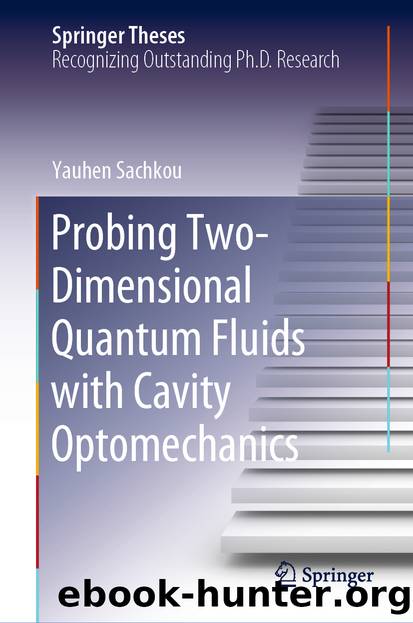Probing Two-Dimensional Quantum Fluids with Cavity Optomechanics by Yauhen Sachkou

Author:Yauhen Sachkou
Language: eng
Format: epub
ISBN: 9783030527662
Publisher: Springer International Publishing
We next investigate the effect of the heat generated due to optical absorption on the microtoroid temperature. To do so, we determine the temperature of the microtoroid mechanical mode as a function of the laser power. The temperature is obtained through integrating the power spectral density of the flexural mode and is observed to grow with rising laser power. Increasing optical heat results in thermal effects that degrade the system above certain threshold. In the case of our superfluid —based system this thermal degradation corresponds to boil-off of the superfluid film, as shown in Fig. 3.4b. First, while the laser power is increased over two orders of magnitude from 10 nW to 2.1 W, the microtoroid mode temperature grows only modestly from 510 to 730 mK. However, when the laser power is further increased above 2.2 W, the mechanical mode temperature exhibits an abrupt jump to about 3 K, which is indicated by the shaded area in Fig. 3.4b. This threshold is a consequence of the upper limit on the superfluid flow rate through the narrowest point of the pedestal which is dependent upon the optical heat power (see Sect. 3.2.2). The maximal flow rate through the junction between the pedestal and the microtoroid dictates the maximal optical thermal load which can be balanced out by the superfluid film. Plugging in the boil-off power of W into Eq. (3.15) for the flow velocity through the constriction point of the pedestal, yields 30 m/s, that is in the vicinity of the superfluid critical velocity beyond which superfluidity breaks down and the superfluid flow ceases to be dissipationless. This causes a thermal run-away process, whereby the superfluid at the outer boundary of the resonator can no longer be replenished at the same rate as it evaporates and, hence, boils off entirely. As a result, thermalization of the microtoroid breaks and the resonator is no longer thermally anchored to the cryostat through the efficient superfluid link, but rather through the thermal conductance of its silicon pedestal, with its final temperature dominated by the optically generated heat.
Download
This site does not store any files on its server. We only index and link to content provided by other sites. Please contact the content providers to delete copyright contents if any and email us, we'll remove relevant links or contents immediately.
| Automotive | Engineering |
| Transportation |
Whiskies Galore by Ian Buxton(41937)
Introduction to Aircraft Design (Cambridge Aerospace Series) by John P. Fielding(33092)
Small Unmanned Fixed-wing Aircraft Design by Andrew J. Keane Andras Sobester James P. Scanlan & András Sóbester & James P. Scanlan(32763)
Craft Beer for the Homebrewer by Michael Agnew(18196)
Turbulence by E. J. Noyes(7977)
The Complete Stick Figure Physics Tutorials by Allen Sarah(7336)
Kaplan MCAT General Chemistry Review by Kaplan(6899)
The Thirst by Nesbo Jo(6877)
Bad Blood by John Carreyrou(6581)
Modelling of Convective Heat and Mass Transfer in Rotating Flows by Igor V. Shevchuk(6406)
Learning SQL by Alan Beaulieu(6237)
Weapons of Math Destruction by Cathy O'Neil(6214)
Man-made Catastrophes and Risk Information Concealment by Dmitry Chernov & Didier Sornette(5956)
Digital Minimalism by Cal Newport;(5704)
Life 3.0: Being Human in the Age of Artificial Intelligence by Tegmark Max(5512)
iGen by Jean M. Twenge(5384)
Secrets of Antigravity Propulsion: Tesla, UFOs, and Classified Aerospace Technology by Ph.D. Paul A. Laviolette(5332)
Design of Trajectory Optimization Approach for Space Maneuver Vehicle Skip Entry Problems by Runqi Chai & Al Savvaris & Antonios Tsourdos & Senchun Chai(5037)
Pale Blue Dot by Carl Sagan(4953)
